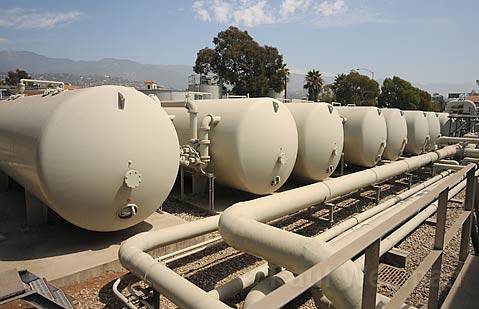Desal, the Climate Crisis, and Our Children’s Future
Is the Desal Plant a $65 Million Mistake?

Desalination is a desperate choice for Santa Barbara, but fortunately it’s not necessary. With its huge cost, risk, and climate footprint, it assumes water users put lush landscapes ahead of our children’s future. Do we? Let’s slow down, take a deep breath, and look at the facts.
Desal adds fuel to the climate fire; climate-friendly landscaping doesn’t. The fossil-fuel-fed climate crisis has made this drought the driest on record. Desal’s huge power demand, which can’t be met by renewables, sharply increases fossil fuel burning. Is it sensible to solve any problem by worsening its cause?
Climate scientists warn that boosting, instead of cutting, our fossil fuel use inflicts increasing droughts, monster storms, rising seas, and global famine on the planet. Economists warn of social, economic, and political chaos. Is maintaining water-intensive landscapes worth leaving this legacy to our children?
Conventional landscapes consume about half our water. Climate-friendly landscapes, however, funnel rain and gray water to irrigate plants. Thick layers of mulch create a rich organic soil sponge to hold water and nourish plants for months. Plants suited to Santa Barbara’s Mediterranean climate look beautiful through the long dry season with minimal water and maintenance, and no mow and blow noise or fumes.
Desal rates are unfair; without desal, rates can be increased fairly to reduce consumption and finance climate-friendly landscaping. Water rates will go up because the cheapest water source is disappearing until rains refill Lake Cachuma. But the proposed desal rates go up 38 percent for high water users, 47 percent for low water users, and 56 percent for urban agriculture. By eliminating the massive capital cost of desal — estimated to be $65 million-plus, including financing and minimum operating costs — rates can be increased fairly to cut consumption, maximize temporary water purchases, and support a rapid transition to climate-friendly landscaping designed for water conservation and beauty.
Santa Barbara is behind in supporting such landscaping. Los Angeles, San Diego, Orange, and Bay Area counties offer rebates of $2-$4 per square-foot for lawn replacement, including labor costs. Maximum rebates are several thousand dollars.
Santa Barbara only rebates half of material costs, not labor, up to $1,000. Even so, through the end of last year, we already reduced water use 23 percent since Stage 2 started. Fair rate increases that finance climate-friendly landscaping can save more water than desal produces and at less cost. Higher rates and lower use balance each other out on bills. And unlike desal, rates can be more flexible, reflecting weather cycles.
Support for a transition to landscaping appropriate to our region would entail professional training and community education plus substantial rebates and low-interest financing for design, labor, and materials. This investment pays off for decades — without the high operating costs of desal. The local economy is boosted by work designing and installing climate-friendly landscapes. And property values improve because the landscapes are beautiful, functional, and economical to maintain.
Desal is a bad bet; collaboration with local stakeholders to save and access more water is a good one. Some Australian desal plants permanently tripled water rates, and most went idle when rains returned. Our desal facility originally cost a fortune and then never operated, which could easily happen again. If it operates, costs for future generations would balloon as fossil fuel depletion swells energy prices.
One avenue for collaborative research is replenishing groundwater through rainwater infiltration. Even in drought years, far more rain runs off Santa Barbara’s watersheds than we will ever use. Capturing a fraction of that water would provide a long-term sustainable water supply while improving creek and ocean health. Other California communities already do this.
Santa Barbara’s obsolete desal facility should be converted to purify recycled water, as the Orange County Water District does. It would produce cleaner water than we now drink. Its carbon footprint would be far smaller than desal’s.
Desal is one more unsustainable means to maintain an unsustainable lifestyle, including landscaping that consumes roughly half our water. Instead, let’s make the cultural, ecological, and economic transition that gives everyone a better life now and for generations to come.



